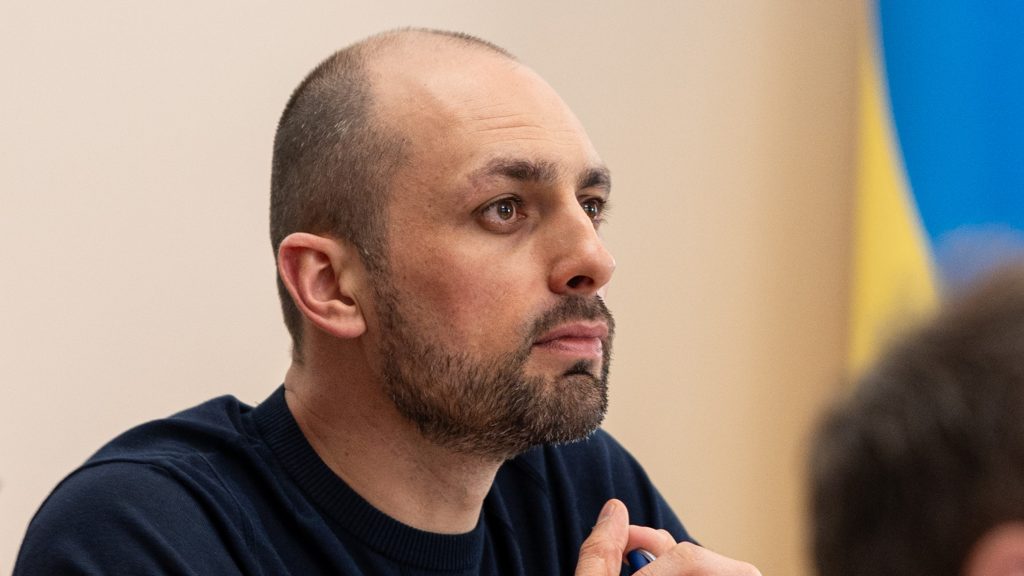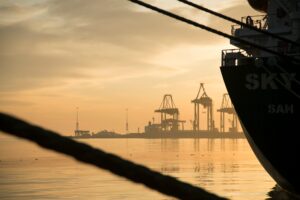“Transshipment in ports is a mirror of the economy.” Interview with the head of the USPA, Oleksandr Semyrha

The port industry is one of the main links of the Ukrainian economy, which is currently forced to operate in extremely difficult conditions. About losses due to the war, competition between ports, challenges in the field of container transportation, as well as investments in the port industry and infrastructure, USM spoke with the head of the Ukrainian Sea Ports Authority, Oleksandr Semyrha.
Tell us, is there a forecast for the final cargo turnover of sea ports in 2025? What factors have a particularly strong impact on the indicators?
Today, the forecasts that were planned for 2025 regarding the volume of transshipment in ports are actually being fulfilled by 97%. In financial indicators, despite a slight drop in volumes, we showed a plus of 7% compared to the planned. At the same time, there are objective factors that affect the decrease in indicators. These are a reduction in sown areas and a decrease in yield, as well as a decrease in the volume of metallurgical production. For example, the latest figures from the State Statistics Service – the volume of agricultural production in Ukraine for 7 months of 2025 decreased by 18.5% compared to last year.
Transshipment in ports is actually a mirror of the economy – how it copes with the difficult conditions of war. It is worth understanding that cargoes exported through seaports must be produced in Ukraine. If production volumes decrease, this is immediately reflected in the transshipment indicators. Similarly with imports: when the economy consumes more goods, grows and develops – import volumes also increase.
At the same time, we look to the future and do everything in our power not only to meet the planned volumes, but also to exceed them. USPA is in constant dialogue with market participants, we are actively working on deregulation, on simplification of administrative procedures, on digitalization of processes. On all those things that facilitate and speed up work in the port. We are effectively performing our service functions. And, despite all the challenges, we have positive expectations.
Tell us, is there a forecast for the final cargo turnover of seaports in 2025? What factors have a particularly strong impact on the indicators?
Today, the forecasts that were planned for 2025 regarding the volume of transshipment in ports are actually being fulfilled by us by 97%. In financial indicators, despite a slight drop in volumes, we showed a plus of 7% compared to the planned. At the same time, there are objective factors that influence the decrease in indicators. These are a reduction in sown areas and a decrease in yield, as well as a decrease in metallurgical production. For example, the latest figures from the State Statistics Service – the volume of agricultural production in Ukraine for 7 months of 2025 decreased by 18.5% compared to last year.
Transshipment in ports is actually a mirror of the economy – how it copes with the difficult conditions of war. It is worth understanding that cargoes exported through seaports must be produced in Ukraine. If production volumes decrease, this is immediately reflected in the transshipment indicators. Similarly with imports: when the economy consumes more goods, grows and develops, import volumes also increase.
At the same time, we look to the future and do everything in our power not only to meet the planned volumes, but also to exceed them. USPA is in constant dialogue with market participants, we are actively working on deregulation, on simplification of administrative procedures, digitalization of processes. On all those things that facilitate and speed up work in the port. We effectively perform our service functions. And, despite all the challenges, we have positive expectations.
To what extent was it possible to increase TEU transshipment as a result of the resumption of container transportation?
In 2024, Ukrainian ports processed almost 130 thousand TEUs – twice as much as a year earlier. The trend continues: in just seven months of 2025, 114.5 thousand TEU have already been processed, which is 88% of the total volume of last year. Container lines are actively increasing volumes and opening new routes. For example, we recently accepted the first calls of a new Turkish container line.
Of course, volumes depend on the security situation. There are cases when, after shelling, individual companies temporarily suspended work. But thanks to the resilience of port workers and companies, work continues, and volumes are increasing.
Before the resumption of work at the ports of Great Odesa, the Administration relied on the development of the Danube region. How do you assess the situation now?
Danube ports are an alternative logistics route for exports, primarily grain, to Europe and the world. Therefore, they will always remain in the field of view of the state and all responsible institutions as an important part of logistics routes. At the same time, it should be recognized that after the opening of the ports of Great Odesa and the reorientation of the Ukrainian corridor to deeper and more convenient ports, cargo turnover on the Danube has significantly decreased. Therefore, we have prepared our proposals and developments regarding a comprehensive program for the development and support of Danube ports, sent them to the Ministry of Development and we hope for positive approval and implementation.
Continuing the theme of challenges, what is the current amount of damage to port infrastructure from Russian attacks? And is it known how much money is needed to restore infrastructure facilities?
Many port infrastructure facilities are located in areas where it is practically impossible to adequately assess their condition and the cost of restoration. As of today, more than 440 damages to port infrastructure facilities have been recorded. However, for example, there are facilities such as the Bug-Dnieper-Lyman Canal.
Today, it is unrealistic to inspect and understand its condition after the explosion of the Kakhovka HPP, as well as to estimate the amount of costs that will be required for restoration, cleanup, etc. Therefore, these are very approximate figures that we can talk about now. According to preliminary estimates by the Ministry of Development, the cost of restoring the industry is at least $1 billion.
Last year, during the privatization auctions of Bilhorod-Dnistrovskyi, information appeared about the depth of the approach channel, which is 1.9 m, compared to the passport 5.5 m. In particular, information was spreading on the network that the problem has not been resolved since the transfer of the approach channel to the USPA. It is interesting to hear your position on this problem.
First of all, it is necessary to state that the Ukrainian corridor, which today exists at the initiative of the state leadership and whose security is ensured by the Defense Forces and the Navy, provides for the direction of ships to three ports of Great Odesa – Chornomorsk, Pivdennyi and Odesa. Therefore, there are no ship calls to the port of Bilhorod-Dnistrovskyi.
We cannot carry out dredging or any other work where mine surveys have not been conducted and the proper level of security has not been ensured. The example of our dredging vessel on the approach channel of the Bystre estuary is particularly illustrative: even within the current corridor, under the conditions of carrying out mine countermeasures, it was damaged by a mine explosion. The vessel was half-sunk, and now we are working to raise and restore it.
Let’s get back to the numbers. Last year, the department’s net financial result exceeded expectations by 2.6 times. Are these funds enough to, for example, cover the needs for infrastructure repairs? Last year, the Administration planned UAH 829 million in capital investments. Is there a similar plan for this year? The priority area of expenditure will probably be the restoration of critical infrastructure, but what other areas in Ukrainian ports require investment? Does the USPA have a plan to attract investment?
Many port infrastructure facilities are located in areas where it is practically impossible to adequately assess their condition and the cost of restoration. As of today, more than 440 damages to port infrastructure facilities have been recorded. However, for example, there are facilities such as the Bug-Dnipro-Lyman Canal.
Today, it is unrealistic to inspect and understand its condition after the Kakhovka HPP explosion, as well as to estimate the amount of costs that will be required for restoration, cleanup, etc. Therefore, these are very approximate figures that we can talk about now. According to preliminary estimates by the Ministry of Development, the cost of restoring the industry is at least $1 billion.
Last year, during the privatization auctions for Bilhorod-Dnistrovskyi, information appeared about the depth of the approach channel, which is 1.9 m with a passport value of 5.5 m. In particular, information was circulating on the network that the problem had not been resolved since the approach channel was transferred to the USPA. It would be interesting to hear your position on this issue.
First of all, it should be noted that the Ukrainian corridor, which today exists at the initiative of the state leadership and whose security is ensured by the Defense Forces and the Navy, provides for the direction of ships to three ports of Great Odesa – Chornomorsk, Pivdennyi and Odessa. Therefore, there are no ship calls to the port of Bilhorod-Dnistrovskyi.
We cannot carry out dredging or any other work where mine-clearing surveys have not been conducted and the proper level of security has not been ensured. The example of our dredging vessel on the approach channel of the Bystroye estuary is particularly illustrative: even within the current corridor, under the conditions of carrying out mine-clearing activities, it was damaged by a mine explosion. The vessel was half-sunk, and now we are working to raise and restore it.
Let’s return to the numbers. Last year, the department’s net financial result exceeded expectations by 2.6 times. Are these funds enough to, for example, cover the needs for infrastructure repairs? Last year, the Authority planned UAH 829 million in capital investments. Is there a similar plan for this year? The priority area of expenses will probably be the restoration of critical infrastructure, but what other areas in Ukrainian ports require investments? Does the USPA have a plan to attract investments?
Last year, the USPA managed to implement only UAH 305.7 million in capital investments. As for the plans for now: over UAH 8 billion in capital investments are planned for the coming years. More than half of this amount is the company’s own funds, the rest is funds received from international partners, which will be implemented through relevant state programs.
Whether we will be able to implement the entire volume – we will see, but we are doing everything to ensure that the percentage of implementation of these programs is as high as possible. And when we talk, for example, about infrastructure, we mean a comprehensive action plan: this includes repairs, modernization of existing facilities, and fleet renewal, including the acquisition of new vessels to replace those that were lost or damaged, or have become obsolete since Soviet times.
Let me explain why this is important: we are clearly aware that all processes related to the reconstruction or construction of complex hydraulic structures take years, and the construction of any vessel takes from 1 to 3 years. After the victory, the load on ports will definitely be maximized, the challenges will only grow. Therefore, an important part is not only infrastructure projects directly, but also the development of digitalization, simplification of administrative procedures and the introduction of the latest technologies, investments in which we are also actively working.
The latest news indicates that the USPA is studying the practices of managing port infrastructure in other countries, in particular the USA. What experience of foreign management can be implemented in Ukrainian ports?
This is an extremely relevant topic, because despite all the challenges and threats, we are looking to the future. We do not want to stand still – we need to move forward quickly, and that is why we are applying a comprehensive approach.
On the one hand, as I have already said, this is digitalization and reducing bureaucratic procedures. It is important to note the DocPort system, which we are implementing much faster than planned.
On the other hand, this is the automation of many processes and the application of new technologies: from the use of drones for measurements and survey work in the water area to studying the experience of unmanned pilotage of vessels, which is already being tested by individual countries.
Another direction is the creation of situational coordination centers, where all information will be concentrated: from vessel calls and work planning to safety and environmental monitoring. This is especially important, since Ukraine is a party to international conventions and must fulfill international convention obligations and adhere to high standards of environmental and maritime safety.
We are actively cooperating not only with the United States and EU countries, but also studying the experience of Japan and Korea, conducting negotiations at the level of the Ministry of Community and Territorial Development to involve their experts. All this will become the basis of a comprehensive plan, which may even require a revision of the current port development strategy, approved back in 2018.





